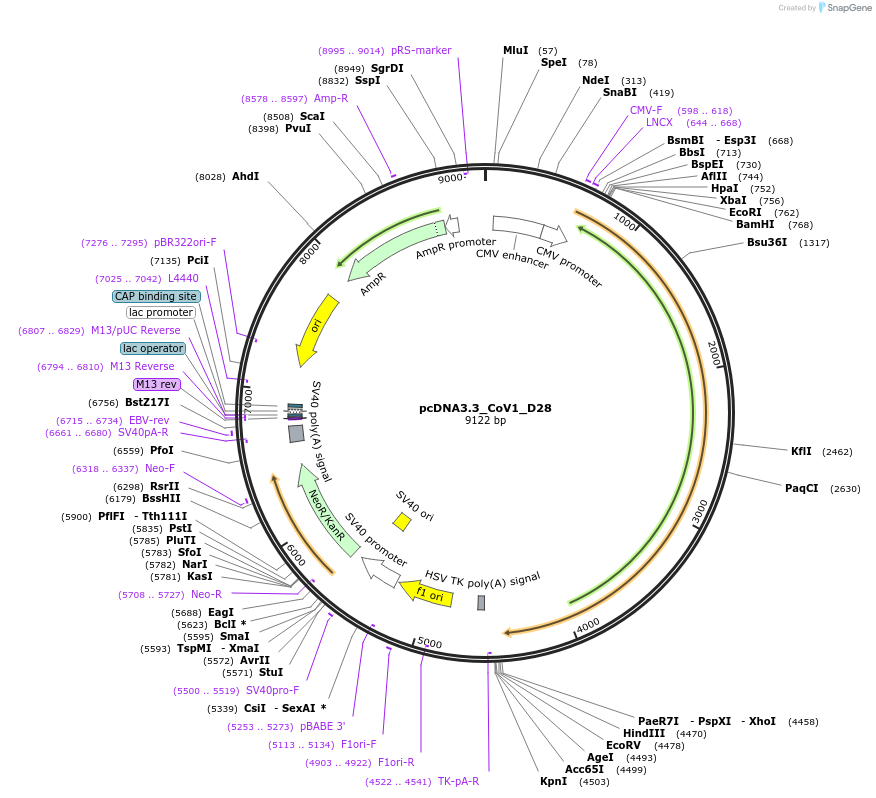-
PurposeExpress SARS-CoV-1 WT spike protein with a 28aa deletion on the C-terminal tail. Used for SARS1 pseudotyped virus production.
-
Depositing Lab
-
Sequence Information
Ordering
| Item | Catalog # | Description | Quantity | Price (USD) | |
|---|---|---|---|---|---|
| Plasmid | 170447 | Standard format: Plasmid sent in bacteria as agar stab | 1 | $85 | |
Backbone
-
Vector backbonepcDNA3.3
- Backbone size w/o insert (bp) 5500
- Total vector size (bp) 9122
-
Vector typeMammalian Expression
-
Selectable markersNeomycin (select with G418)
Growth in Bacteria
-
Bacterial Resistance(s)Ampicillin, 100 μg/mL
-
Growth Temperature37°C
-
Growth Strain(s)DH5alpha
-
Copy numberHigh Copy
Gene/Insert
-
Gene/Insert nameSARS-CoV-1 spike D28
-
SpeciesSARS-CoV-1
-
Insert Size (bp)3800
-
Mutationlast 28aa deletion in c-terminal tail
-
Entrez GeneS (a.k.a. sars2, E2)
- Promoter CMV
-
Tag
/ Fusion Protein
- NA
Cloning Information
- Cloning method Restriction Enzyme
- 5′ cloning site BamHI (not destroyed)
- 3′ cloning site XhoI (not destroyed)
- 5′ sequencing primer CMV-F
- 3′ sequencing primer TK-pA-R (Common Sequencing Primers)
Resource Information
-
Supplemental Documents
-
Articles Citing this Plasmid
Terms and Licenses
-
Academic/Nonprofit Terms
-
Industry Terms
- Not Available to Industry
Trademarks:
- Zeocin® is an InvivoGen trademark.
These plasmids were created by your colleagues. Please acknowledge the Principal Investigator, cite the article in which the plasmids were described, and include Addgene in the Materials and Methods of your future publications.
-
For your Materials & Methods section:
pcDNA3.3_CoV1_D28 was a gift from David Nemazee (Addgene plasmid # 170447 ; http://n2t.net/addgene:170447 ; RRID:Addgene_170447) -
For your References section:
Isolation of potent SARS-CoV-2 neutralizing antibodies and protection from disease in a small animal model. Rogers TF, Zhao F, Huang D, Beutler N, Burns A, He WT, Limbo O, Smith C, Song G, Woehl J, Yang L, Abbott RK, Callaghan S, Garcia E, Hurtado J, Parren M, Peng L, Ramirez S, Ricketts J, Ricciardi MJ, Rawlings SA, Wu NC, Yuan M, Smith DM, Nemazee D, Teijaro JR, Voss JE, Wilson IA, Andrabi R, Briney B, Landais E, Sok D, Jardine JG, Burton DR. Science. 2020 Aug 21;369(6506):956-963. doi: 10.1126/science.abc7520. Epub 2020 Jun 15. 10.1126/science.abc7520 PubMed 32540903





